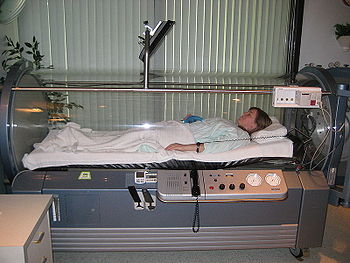Hyperbaric oxygen therapy
From Wikiwel
Other names: hyperbaric medicine, hyperbarics, HBOT, HBO2.
is the medical use of oxygen at a level higher than atmospheric pressure in a sealed chamber that has been pressurized at 1-1/2 to 3 times normal atmospheric pressure.
See also :
Contents
Special Precautions of Hyperbaric oxygen therapy
- HBOT is a relatively safe method for selected patients getting approved medical treatments. Complications are lessened if pressures within the hyperbaric chamber stay below three times the normal atmospheric pressure and sessions last no longer than 2 hours. There are some people who should not get HBOT, however.
- Milder problems associated with HBOT include claustrophobia, fatigue, and headache. More serious complications include myopia (short-sightedness) that can last for weeks or months, sinus damage, ruptured middle ear, and lung damage. A complication called oxygen toxicity can result in seizures, fluid in the lungs, and even respiratory (lung) failure. Patients at high risk of oxygen toxicity may be given "air breaks" during which they breathe ordinary air rather than pure oxygen for short periods during treatment.
- People with severe congestive heart failure may have their symptoms worsened by HBOT. Patients with certain types of lung disease may be at higher risk of collapsed lung during HBOT. Pregnant women should be treated with HBOT only in serious situations where there are no other options. People getting certain chemotherapy drugs (such as bleomycin, doxorubicin, or cisplatin) should not get HBOT. Anyone getting disulfiram (Antabuse) or using sulfamylon cream should not get HBOT, nor should anyone with a collapsed lung.
- A person with a pacemaker, high fever, or even a cold can be harmed by HBOT. Someone with claustrophobia would likely have trouble being in the HBOT chamber.
- Hyperbaric oxygen chambers can be a fire hazard: fires or explosions in hyperbaric chambers have caused about 80 deaths worldwide. Medical hyperbaric chambers today are generally well-built and have good safety records, but certain cautions must always be observed.
- Relying on this treatment alone and delaying or avoiding conventional medical care for cancer may have serious health consequences.
The benefits of Hyperbaric oxygen therapy are
- Hyperbaric oxygen therapy is used in conventional treatment for decompression sickness; severe carbon monoxide poisoning; certain kinds of wounds, injuries, and skin infections; delayed radiation injury; and certain bone or brain infections. Decompression sickness, commonly known as "the bends," is an extremely painful and potentially dangerous condition that strikes deep sea divers who surface too quickly and, occasionally, miners and tunnel builders who come up too rapidly. It can also affect fighter pilots who climb very quickly.
- Claims about alternative uses of HBOT include that it destroys disease-causing microorganisms, cures cancer, relieves chronic fatigue syndrome, and decreases allergy symptoms. A few supporters also claim that HBOT helps patients with AIDS, arthritis, sports injuries, multiple sclerosis, autism, stroke, cerebral palsy, senility, cirrhosis, Lyme disease, and gastrointestinal ulcers. Available scientific evidence does not support these claims. Because of that, the FDA has sent a warning letter to at least one manufacturer about promoting HBOT for unproven uses. The FDA considers oxygen to be a drug, meaning it must be prescribed by a physician or licensed health care provider to treat illnesses or health conditions.
- Diabetes-Related Complications : Hyperbaric oxygen therapy may be beneficial as a short-term treatment for diabetes-related foot ulcers, according to a report published in the Cochrane Database of Systematic Reviews in 2012. However, in their analysis of eight clinical trials on the use of hyperbaric oxygen therapy in treatment of diabetic foot ulcers, the report's authors note that the reviewed trials had various flaws in their design and/or reporting.
- Cancer : In a research review published in Targeted Oncology in 2012, scientists found some evidence that hyperbaric oxygen therapy may help inhibit tumor growth in certain incidences of cancer. However, more research is needed to determine whether hyperbaric oxygen therapy may be effective as a cancer treatment.
References
- American Cancer Society. "Hyperbaric Oxygen Therapy." April 14, 2011.
- Bennett M, Heard R. "Hyperbaric oxygen therapy for multiple sclerosis." Cochrane Database Syst Rev. 2004;(1):CD003057.
- Bennett MH, Wasiak J, Schnabel A, Kranke P, French C. "Hyperbaric oxygen therapy for acute ischaemic stroke." Cochrane Database Syst Rev. 2005 Jul 20;(3):CD004954.
- Kranke P, Bennett MH, Martyn-St James M, Schnabel A, Debus SE. "Hyperbaric oxygen therapy for chronic wounds." Cochrane Database Syst Rev. 2012 Apr 18;4:CD004123.
- Moen I, Stuhr LE. "Hyperbaric oxygen therapy and cancer--a review." Target Oncol. 2012 Dec;7(4):233-42.
- Yildiz S, Uzun G, Kiralp MZ. "Hyperbaric oxygen therapy in chronic pain management." Curr Pain Headache Rep. 2006 Apr;10(2):95-100.
Medical Disclaimer
This information is not meant to be substituted for medical advice. Always consult a medical professional regarding any medical problems and before undertaking any treatment or dietary changes.
